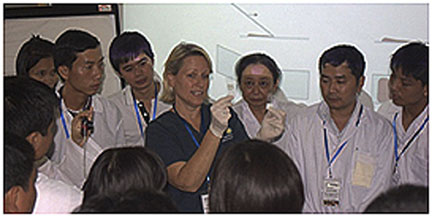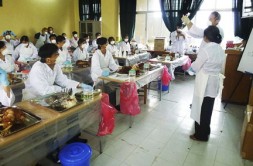Preventing a real “Outbreak” of pandemic disease
Suzan Murray, chief veterinary medical officer at the Smithsonian’s National Zoological Park, recently returned from Hanoi, where she led a team of scientists training pathologists from Laos, Cambodia and Vietnam to better sample, recognize and detect wildlife diseases in hopes of preventing emerging pandemic disease. The National Zoo is one of five organizations participating in PREDICT, one component of the the U.S. Agency for International Development’s Emerging Pandemic Threats program. Dr. Murray recently answered a few questions about the program for Smithsonianscience.org.
Q. Why was this workshop conducted in Vietnam?
A. The Mekong region of Southeast Asia is one of four hotspots in the world where we know pandemic viruses are most likely to emerge. Other hot spots are the Congo Basin of Africa, the Amazon Basin in South America and the Gangetic Plain of South Asia.
Q. You are a veterinarian but you train pathologists to identify human diseases?
A. As the Smithsonian’s Chief Veterinary Medical officer I have the opportunity to help apply some of our valuable resources to help address our collective health care needs. In the past, many of the public health concerns tended to focus primarily on human diseases. Now that we know that so many emerging pathogens are zoonotic initially—SARS [severe acute respiratory syndrome], HIV/AIDS and Ebola to name only a few—it is critical to have veterinarians involved in this process. More than 75 percent of infectious human diseases are zoonotic [a disease shared between humans and other animals]. H5N1 Avian flu, monkey pox, Hantavirus… these viruses began in animals and became global health threats, yet they may have been short circuited had someone identified them when they first appeared as abnormalities in their animal hosts.
Q. How do these diseases start?
A. When animals that don’t usually have contact with each other—domestic chickens, pigs, wild civets—come into close contact, such as they do every day in Asian and African markets, viruses can mutate and jump between species. This is probably occurring all of the time. New viruses also emerge in places where human development brings workers and others into remote areas, such as a new road through a tropical forest, and into close contact with species people and their animals haven’t been in contact with before. Eating bushmeat, for example, can expose you to a new virus. In Bolivia, where villages are expanding into the forest, domestic dogs are vectors for disease between humans and wild animals.
Mix modern global transportation into this equation and a deadly virus can move around the globe to a densely populated area in 24 hours. Our goal with the Emerging Pandemic Threats Program is to prepare and train the next generation of ‘one-health’ professionals, which will include pathologists, to conduct surveillance, recognize and catch these viruses early, BEFORE they become the next pandemic.
Q. What do you train pathologists to look for?

Participants in the Emerging Pandemic Threats workshop held recently in Vietnam perform an avian necropsy..
A. To spot abnormalities, a pathologist must first have a very good understanding of what is normal, so we teach courses on health and disease of primates, bats, rodents, and birds in the morning and then hold wet labs in which the participants perform postmortem examinations on healthy animals, such as domestic birds and pigs. These labs are preceded by lectures on animal pathology… we give short courses on diseases in ungulates [foot-and-mouth disease, tuberculosis, anthrax, brucellosis], diseases in bats and rodents [rabies, Hantavirus, leptospirosis], in amphibians and reptiles [salmonellosis and cryptosporidiosis] and other animals such as carnivores and primates. Because disease presents itself differently in different species, we try to train people to recognize signs of an epizootic (animals epidemic) event—20 dead birds found in someone’s back yard, 100 dead bats at the mouth of a cave, or six elephants acting ill—and to properly observe and gather information. Often, a pathologist in the field may need to collect tissue and blood samples from both live and dead animals—so we train them how to do this in a timely and safe fashion to minimize their exposure to the disease.
Q. What else do participants learn?
A. We teach them a bit of clinical pathology, such as how to do a blood smear on a microscope slide, how to fix, stain and preserve blood and tissue samples and how to take a photomicrograph of a slide and send it off electronically where experts, such as the staff of the National Zoo, can take a look.
One of the main benefits of these workshops is that participants develop a network of colleagues and contacts locally and around the world with whom they can consult and who they can alert. In addition to me, Tim Walsh, NZP chief pathologist, and Chris Whittier, NZP associate veterinarian, along with colleagues from University of Illinois and our PREDICT partner the Wildlife Conservation Society (WCS) participated in this Vietnam workshop. The pathologists who took the course know how to contact us and know we are always ready to assist them in diagnosing a potential outbreak. Along with our main partner on this activity, WCS, other organizations that we are partnered with for PREDICT include the Wildlife Health Center at the University of California, Davis, the EcoHealth Alliance, and the Global Viral Forecasting Initiative.
Q. How did the National Zoo get involved in this project?
A. Along with a staff of federal veterinarians clinically trained in a wide variety of domestic and wildlife species, the Smithsonian’s National Zoo has a long history of researching and innovating methods t0 investigate, diagnose, and treat illnesses in a wide range of species. This combined with the experience and interest of both of our clinical veterinary and pathology teams enabled us to become involved in and contribute to USAID’s Emerging Pandemic Threats program. Our long history and expertise in veterinary pathology, which is something we practice every day in caring for our large collection of animals, gave us the ability to suggest such a workshop. So it was a natural for us to become involved in this workshop. It is an excellent demonstration of the wealth of experts on different species that we have at the Zoo. Our vets can make a HUGE impact and put the Smithsonian way out in front of the next potential outbreak of a potentially deadly pandemic.
[Note: Trainees in the PREDICT workshop from Vietnam included pathologists from the Hanoi University of Agriculture (Faculty of Veterinary Medicine), the National Centre for Veterinary Diagnostics, the National Institute of Veterinary Research, and the Department of Animal Health (Epidemiology Division), all in Hanoi; and the Regional Animal Health Office No. 6 in Ho Chi Minh City. Trainees from Laos PDR and Cambodia include pathologists from the General Department of Livestock and Fisheries, Laos PDR, the National Veterinary Research Institute of Cambodia, and veterinarians from the Forestry Administration Department of Cambodia.]
Posted: 30 November 2011






